Voice Search Statistics By Devices, SEO, Usage And Marketing (2025)
Updated · Sep 24, 2025

Table of Contents
- Introduction
- Editor’s Choice
- General Voice Search Statistics
- Global Speech And Voice Recognition Market Statistics
- Global Voice Commerce Statistics
- Voice Search Statistics By Voice And Voice-Enabled Devices
- Voice Assistant User Statistics By Brand
- Share of People Using Voice-Enabled Devices
- Voice Search Devices Statistics
- Voice Search Accuracy Statistics
- Voice Search Usage Statistics
- Voice Search SEO Statistics
- Voice Search Customer Preferences Statistics
- Voice Search And Consumer Behaviours Statistics
- Purchasing Using Voice Search Statistics
- Voice Search Statistics By Devices
- Voice Search Usage Statistics By Sectors
- Voice Search Optimisation And Web Presence Statistics
- Voice Search And SEO Statistics
- Voice Search And Local Business Statistics
- Voice Search Marketing Statistics
- Reasons Voice Search Is So Popular
- Conclusion
Introduction
Voice Search Statistics: As today’s world advances technologically, the generation is increasingly inclined towards voice search rather than typing. Globally, voice search is becoming increasingly popular in a short period, reshaping the online interaction process. Mostly used for finding online information, whether it’s asking your phone about the weather, looking up a recipe, or finding the nearest coffee shop.
The technology of voice search has evolved in response to the rise of virtual assistants, including Siri, Alexa, and Google Assistant. The voice search trend is significantly impacting SEO and digital marketing strategies as users increasingly favour the convenience and speed of voice search over traditional typing.
This article presents the latest statistical analyses from various insights that will help you gain a deeper understanding of the topic.
Editor’s Choice
- The Yaguara report claimed that by 2025, nearly 20.5% of the global population will be using voice search.
- It is also estimated that by the end of this year, the total number of voice assistants in use will be around 8.4 billion.
- 93.7% of queries are accurately answered when questioned by Voice search assistants.
- It typically takes around 4.6 seconds for a voice search result page to load fully.
- For finding out local businesses, almost 76% of consumers use voice searches.
- According to eMarketer’s report analysis, in 2024, approximately 149.1 million Americans were using voice assistants, and by the end of 2027, this number is expected to reach around 162.7 million users.
- In the U.S., approximately 91.4 million people are estimated to use smart speakers to ask questions via voice searches by the end of 2026.
- The PYMNTS report further states that, within the next five years, approximately four out of every ten U.S. people believe voice technology will feel like talking to a real person.
- In the coming years, 54% of customers are expected to prefer voice search technology over typing.
- Over the last 12 months, nearly 24% of consumers have used voice-activated devices to search for information.
- Around 22% of Gen Z are very willing to spend over USD 10 per month on a smart voice assistant.
- Yaguara also states that in 2025, the market size of speech recognition is expected to grow to USD 21 billion and is estimated to reach USD 47 billion by the end of 2030.
General Voice Search Statistics
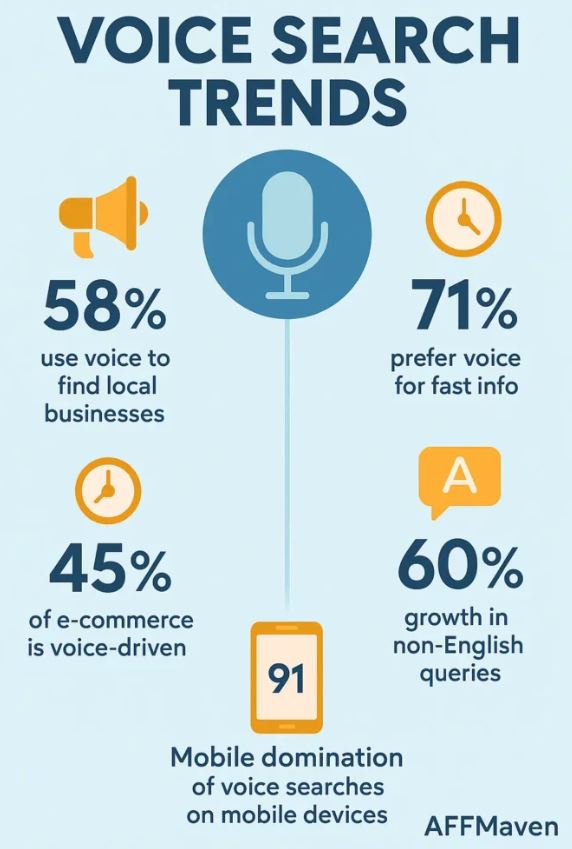
(Source: affmaven.com)
- As of May 2025, approximately 58% of people use voice search to find nearby places, such as restaurants or services.
- Moreover, around 45% of e-commerce shopping is supposed to be done by voice searches.
- On mobile phones, nearly 9 out of 10 voice searches (representing 91%) currently take place.
- Voice searches in languages other than English have grown by 60%.
- 71% of users preferred voice searches because they provide quick answers without requiring typing.
Global Speech And Voice Recognition Market Statistics
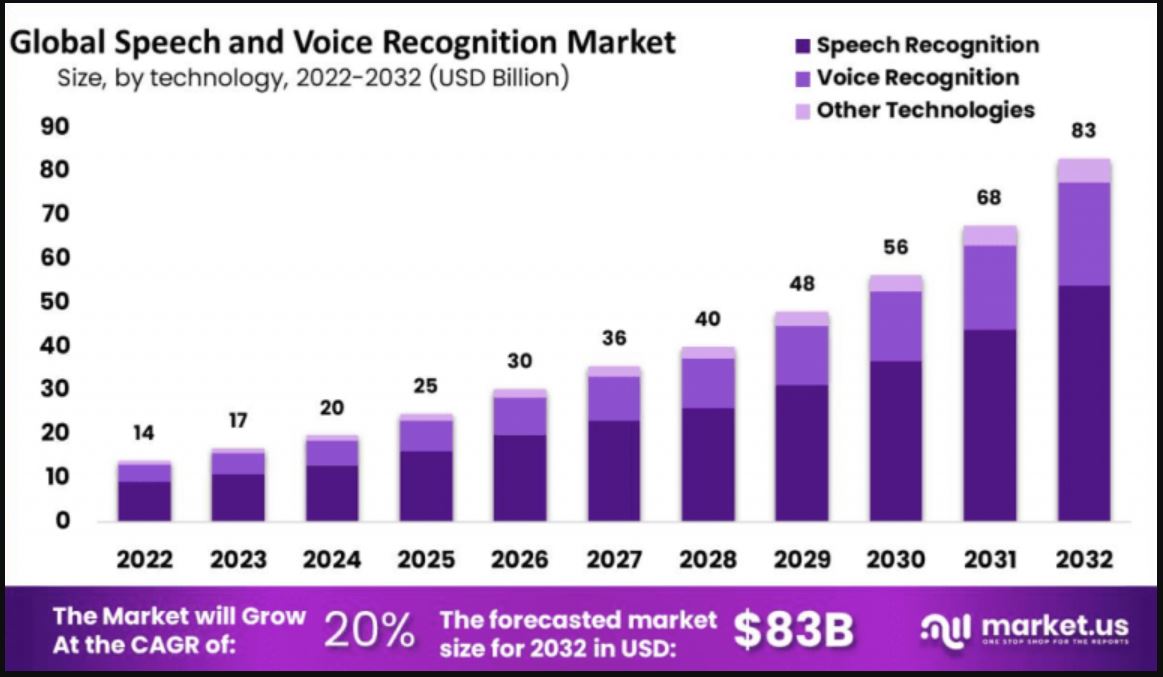
(Source: keywordseverywhere.com.com)
- The above graph indicates that by the end of 2025, the global market size for speech and voice recognition is expected to reach approximately USD 25 billion, and is estimated to grow to USD 83 billion by the end of 2032.
- The market is expected to grow at a 20% CAGR from 2022 to 2032.
- Furthermore, the estimated market size for the years 2026 (USD 30 billion), 2027 (USD 36 billion), 2028 (USD 40 billion), 2029 (USD 48 billion), 2030 (USD 56 billion), and 2031 (USD 68 billion) is projected.
Global Voice Commerce Statistics

(Reference: affmaven.com)
- By 2025, the global voice commerce market size is projected to reach USD 40 billion, and by the end of 2026, it is expected to surpass USD 100 billion.
- Every month, 11.5% of American adults who own smart speakers use them for shopping.
- Around 34% of those who don’t have a voice assistant yet are interested in getting one soon.
Voice Search Statistics By Voice And Voice-Enabled Devices
- A Statista report states that by 2025, around 75% of U.S. people will own at least one smart speaker.
- Yaguara.co further states that at least once in their lifetime, 58.6% of American residents have tried voice searches.
- On mobile devices, only 27% of people have used voice searches in recent years.
The table below shows the number of voice assistant users in the United States of America:
| Year | Number of users (million) |
Change rate |
| 2023 | 145.1 | 2.9% |
| 2024 | 149.3 | 2.9% |
| 2025 | 154.3 | 3.3% |
| 2026 | 159.3 | 3.2% |
| 2027 | 164.6 | 3.4% |
| 2028 | 170.3 | 3.4% |
(Source: emarketer.com)
- Every month, over 1 billion voice searches are conducted.
- The Learn.G2 report further states that voice searches are used regularly by 21% of people, resulting in one in five people.
- Global Web Index also shows that 34% of people who don’t have a voice assistant say they would like to buy one in the future.
- According to Blogging Wizard, voice search remains a widely used activity, ranking sixth among the most common tasks people perform using voice.
Voice Assistant User Statistics By Brand
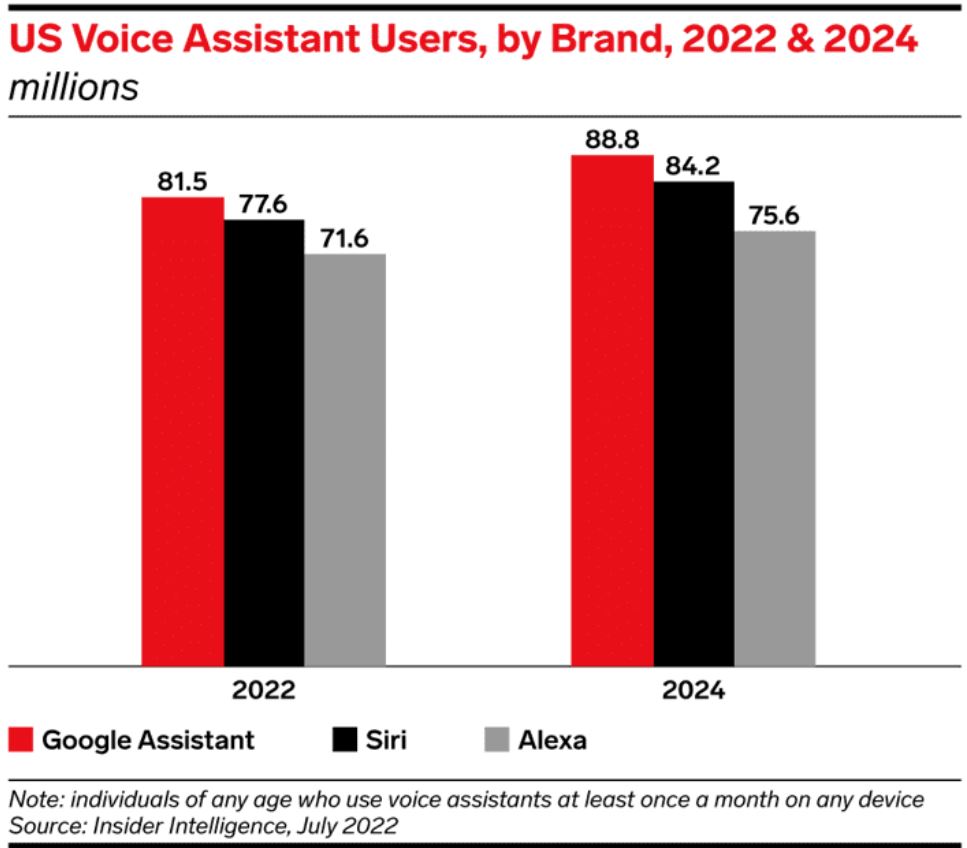
(Source: keywordseverywhere.com)
- In 2024, Google Assistant had approximately 88.8 million voice assistant users in the United States and is expected to reach 92 million by the end of 2025.
- Followed by Siri with 84.2 million users and Alexa with 75.6 million users in 2024.
- Meanwhile, in 2025, Siri and Alexa are expected to gain 86.5 million and 77.2 million users, respectively.
By Smartphone vs. Total
| Year | Smartphone Users (million) |
Total users (million) |
| 2023 | 128.3 | 145.1 |
| 2024 | 133.1 | 149.1 |
| 2025 | 137.3 | 153.4 |
| 2026 | 141.4 | 157.9 |
| 2027 | 145.9 | 162.7 |
By Generation
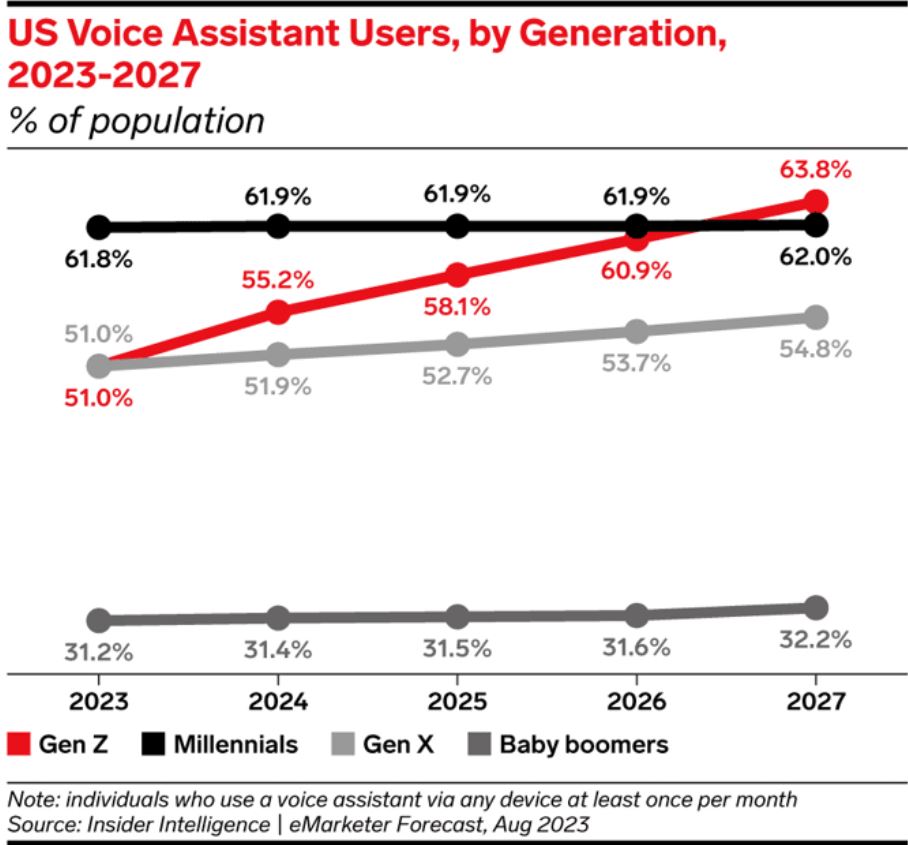
(Source: keywordseverywhere.com)
- The above graph indicates that by 2025, in the United States, 61.9% of millennials are expected to be using voice assistants.
- Other generations’ voice assistant users in the U.S. are followed by Gen Z (58.1%), Gen X (52.7%), and Baby Boomers (31.5%).
| Year | Gen Z | Millennials | Gen X | Baby Boomers |
| 2026 | 60.9% | 61.9% | 53.7% | 31.6% |
| 2027 | 63.8% | 62% | 54.8% | 32.2% |
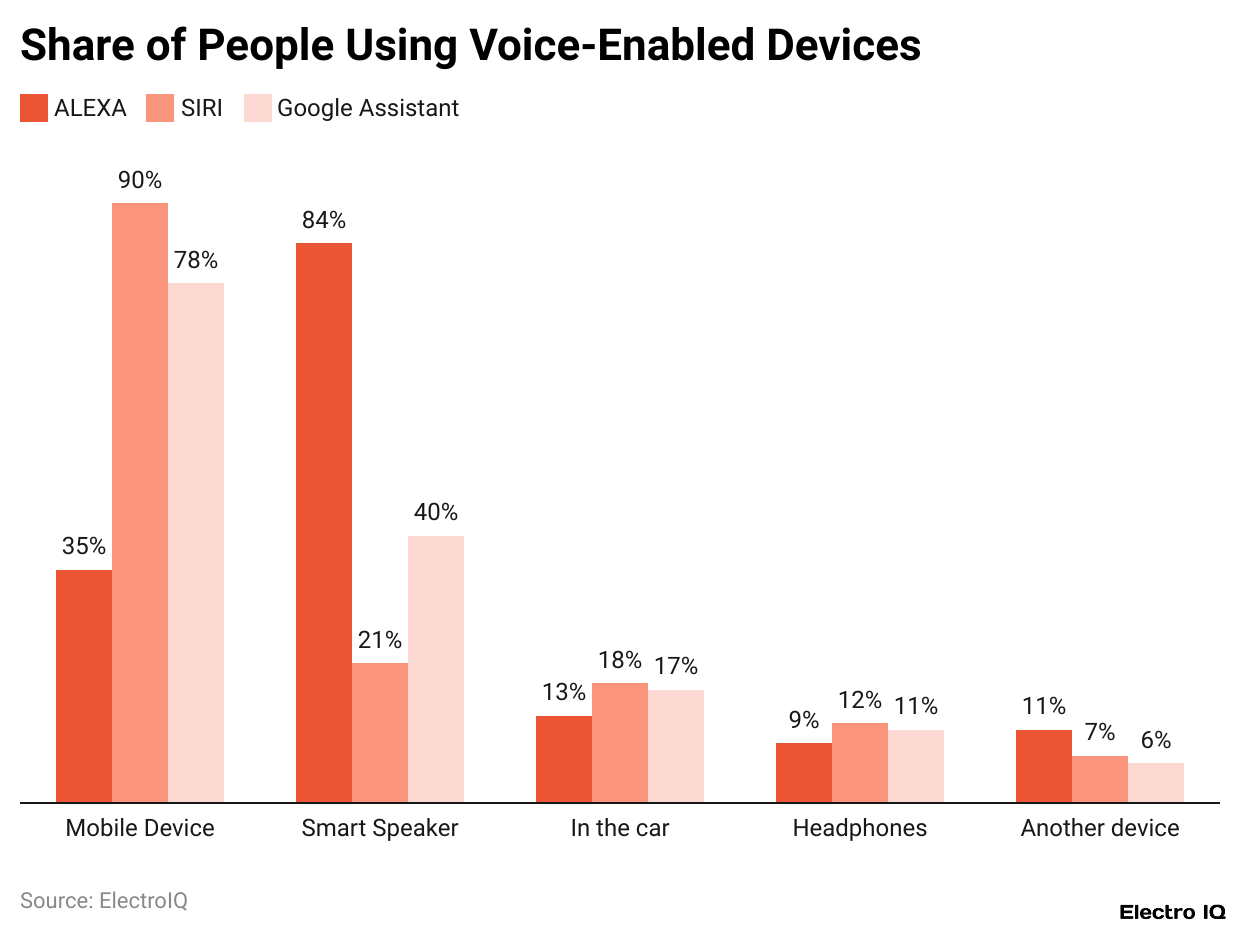
(Reference: keywordseverywhere.com)
- By the end of 2024, Siri was the most popular smart speaker used for voice searches in the U.S, with around 90% of users using it on mobile devices, followed by Google Assistant (78%) and Alexa (35%).
- At the same time, smart speakers utilising Alexa secured a user share of 84%, Google Assistant (40%), and Siri (21%).
Furthermore, other user shares are mentioned below for 2024:
| Use Cases | Alexa | Siri | Google Assistant |
| In Car | 13% | 18% | 17% |
| Headphones | 9% | 12% | 11% |
| Another device | 11% | 7% | 6% |
Voice Search Devices Statistics
- As of 2025, 27% of voice search users preferred mobile devices for carrying out voice searches.
- Meanwhile, around 36% of global people find the Google Assistant to be the most popular digital assistant, and another 36% prefer Apple’s Siri.
- Followed by Amazon Alexa holding a share of 25% and Microsoft Cortana with 19% of the share.
- The remaining digital assistants are used by 1% of the global population.
Voice Search Accuracy Statistics
| Digital Assistant | Answered Correctly |
Understood Questions |
| Alexa | 79.8% | 99.9% |
| Siri | 83.1% | 99.8% |
| Google Assistant | 92.9% | 100% |
- AFFMaven report further states that 93 out of 100 people are happy with how their voice assistants work.
- In contrast, 65% of smart speaker users say they can no longer imagine living without their smart speakers.
Voice Search Usage Statistics

(Source: backlinko.com)
- Internet users aged 16 to 64 years are weekly users of voice assistants, accounting for a 30% share in 2024.
- In the same duration, the United States had 98 million smart speaker users.
- Meanwhile, in the U.S., 33.6% of internet users aged 16 to 64 report using voice assistants on a weekly basis.
- On average, more men use voice assistants every week compared to women.
- A Backlinko report analysis indicates that, as of 2024, approximately 39.3% of Chinese internet users utilise voice assistants every week.
- In the United States and the United Kingdom, almost 28% of regular voice assistant users.
- On smartphones, almost 45% of U.S. people use voice searches.
- As of 2024, based on demographics, the country’s monthly smartphone voice assistant users are millennials (61.9%), Gen Z (55.2%), Gen X (51.9%), and Baby Boomers (31.5%).
- Google’s mobile voice search supports more than 70 languages.
Voice Search SEO Statistics
- The Backlinko report states that 10,000 Google Home voice searches were conducted, and the results load in about 4.6 seconds on average.
- On average, voice search results are short and contain around 29 words.
- In voice searches, link authority and high domain-linked websites rank at the top.
- Featured Snippet helps to get 40.7% of answers from voice search.
- Google Voice Search often shows content that’s popular online, with approximately 1,199 Facebook shares and 44 Tweets on average.
- Meanwhile, Google Voice Search answers come from pages that have approximately 2,312 words each.
- Most voice search answers use simple, clear words that a ninth-grade student can easily understand.
Voice Search Customer Preferences Statistics
- About 34 out of every 100 people in the U.S. have a voice-controlled smart speaker.
- In contrast, these users ask their smart speaker to do around 11 different things each week.
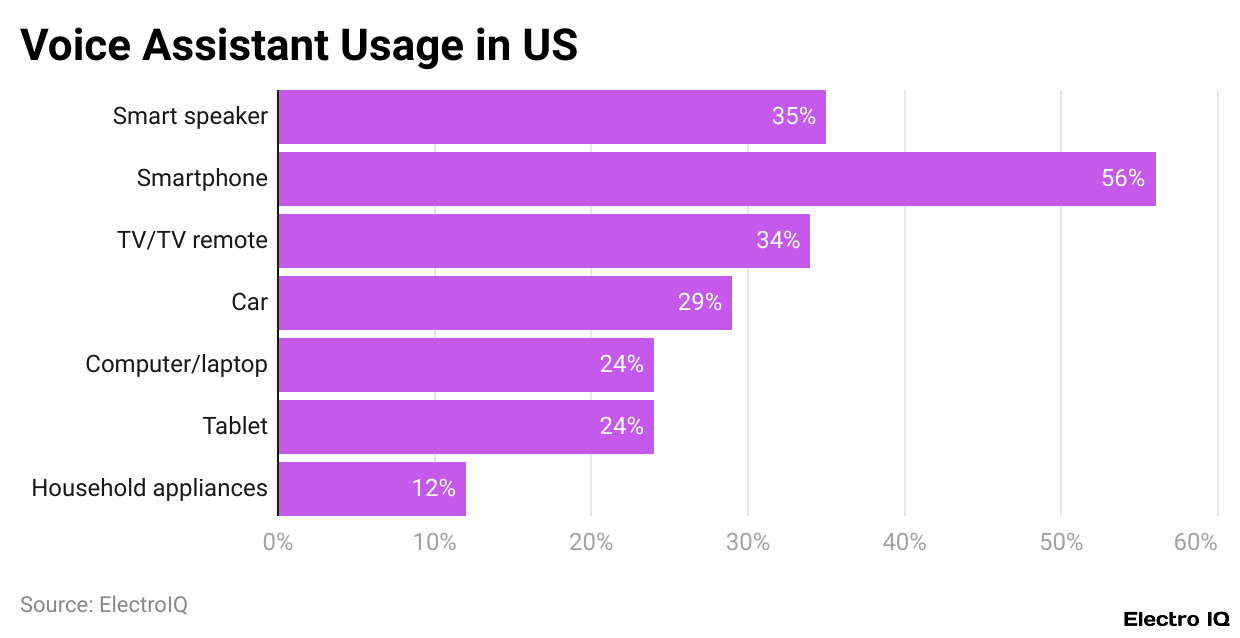
(Reference: backlinko.com)
- In the United States, the top three devices for voice assistant usage are Smartphones (56%), smart speakers (35%), and TV & TV remotes (34%).
- Furthermore, other voice assistant usage shares are followed by cars (29%), computers and laptops (24%), tablets (24%), and household appliances (12%).
Voice Search And Consumer Behaviours Statistics
- DemandSage further states that in the United States, approximately 72% of customers utilise digital assistants to conduct voice searches.
- On the other hand, 35% of consumers use a smart home speaker for voice search, followed by 36% (using a TV or smart home device), and 31% (for voice commands in vehicles).
- Additionally, when researching products, 51% of U.S. online shoppers reported using voice assistance, while 30% use voice assistants to track their packages.
- Followed by 20% of users to rate a product, 17% of online shoppers are willing to repurchase items, and 40% of users reported purchasing a product after listening to its voice advertisement.
Purchasing Using Voice Search Statistics
- According to Backlinko’s reports, in the United States, approximately 38.8 million people use smart speakers for shopping through voice searches.
- Around 13.6% of the population uses them to search for products or add items to their cart.
- Meanwhile, voice search for regular shopping was used by only 8% of U.S. adults.
- People mostly use voice search for simple tasks, such as playing music or setting alarms, rather than for more complex tasks like shopping.
- Over one in three American adults (35%) want to try voice shopping, but haven’t used it yet.
Voice Search Statistics By Devices
| Devices | 18 to 34 Years | 35 to 54 Years | 55 Years + |
| Smartphone | 77% | 63% | 30% |
| Desktop/Laptop | 38% | 32% | 15% |
| Smart speaker | 37% | 32% | 9% |
| Don’t want to use | 9% | 12% | 30% |
| Not used, but would consider using voice search | 15% | 24% | 33% |
Voice Search Usage Statistics By Sectors
- According to Yaguara, three out of four Americans use voice assistants mostly to check the weather in 2025.
- Meanwhile, about 71% of people use them to listen to music, followed by news (64%), and entertainment (62%).
Furthermore, other sectors’ voice search users in the United States are stated in the table below:
| Sectors | User share |
| Retail | 54% |
| Food delivery and restaurants | 52% |
| Healthcare and wellness | 51% |
| Consumer packaged food | 49% |
| Local services | 49% |
| Making a reservation | 47% |
| Fitness | 46% |
| Fashion | 45% |
| Travel | 43% |
| Finance | 42% |
| Other | 42% |
By Industry
- A DemandSage report analysis for 2025 reveals that approximately 51% of people who frequently use voice search or smart speakers look for restaurants or cafes, followed by grocery stores (41%), and food delivery services (35%).
Furthermore, other shares of voice search users in different industries are mentioned below:
| Industry | User share |
| Clothing stores | 32% |
| Hotels | 30% |
| Doctors | 28% |
| Pubs/Bars | 27% |
| Hair/ Beauty | 26% |
| Dentists | 24% |
| Automotive services | 23% |
The table below also represents the share of professionals using voice technology in different industries:
| Industry | Professional share of voice technology |
| Subtitling & closed captioning | 14% |
| Customer experience & analytics | 12% |
| Media & comms monitoring | 10% |
| Web conferencing transcription | 9% |
| Education, academic, research transcription | 7% |
| Automotive command & control | 7% |
| Digital asset management | 6% |
| Chat app messaging | 5% |
| Compliance | 2% |
| Other | 28% |
By Business
- Currently, 52% of voice search users express a desire to receive information about deals, promotions, and sales from various brands.
- Additionally, 48% of owners stated that they would appreciate helpful tips and advice tailored to their interests.
- Furthermore, another share of voice searches by business owners are followed by 42% (information about upcoming events or activities), 39% (options to find information about store location and hours), and 38% (access to customer support or service).
Voice Search Optimisation And Web Presence Statistics
- Learn.G2.com states that more than 34% of voice search answers are generated from websites using structured data markup on their pages.
- Similarly, the snippet box enables users to access 50% of the answers from voice search.
- Besides, 95% of Google’s voice recognition makes it easy for users to trust the results.
- As of 2024, the best keywords for voice searches are “best,” “easy,” “free,” “top,” and “list,” among others, which are expected to increase by 20% in 2025.
- Voice search answers appear 52% faster than other regular search results on average.
- Voice search assistants are now significantly more intelligent and can accurately answer about 93% of the time.
Voice Search And SEO Statistics
- Only 22.8% of SEO professionals considered voice searches to be the most significant emerging factor in SEO, according to DemandSage reports.
- On Google Assistant, almost 80% of the voice search answers come from the top three search results.
- Webpages that appear in voice search results usually open 52% faster than other pages.
- Web pages with titles that exactly match the search question come from only 1.71% of voice search answers.
- Over 70% of websites in Google voice search results utilise secure HTTPS connections.
- Pages that appear in voice search results typically have an average of around 2,312 words.
Voice Search And Local Business Statistics
- According to Learn G2, to find out nearby or local businesses also 76% of voice searches are expected to be done in 2024.
- In contrast, to find local shops, 82% of smartphone users are using search engines.
- About 58% of people use voice search to find local shops or services near them.
- On Windows 10 computers, one out of every four searches is done by speaking to Cortana.
- 50% of people enjoy using voice search when they want to find nearby businesses.
- About 27% of people visit a local business’s website after using voice search.
- More than 50% of consumers have used their voice to search for local business details in the last year.
- One in four people is willing to use voice search to discover nearby shops.
- About 22% of all voice searches are for local information.
- 62% of people use voice search to look for nearby businesses while they’re driving.
Voice Search Marketing Statistics
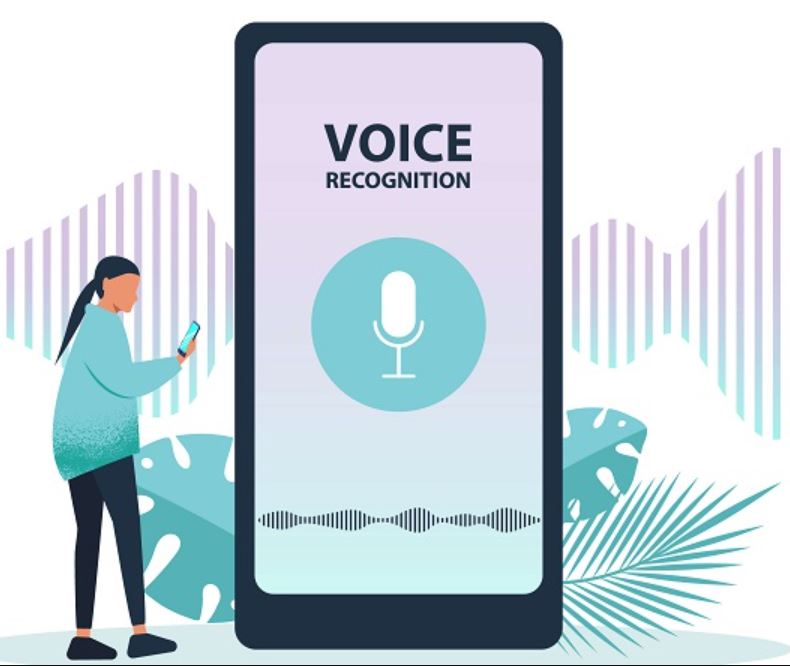
(Source: thrivemyway.com)
- According to the Thrive My Way report analysis, 71% of business leaders believe that voice search enhances the customer experience.
- Around 66% also believe it helps increase sales and improve conversion rates.
- Phone calls generate 10 to 15 times more revenue than leads from websites.
- For reaching customers, 84% of digital marketers say phone calls lead to better results and bigger purchases.
- Over one in three people feel that voice ads are more interesting and less annoying than ads on TV, in newspapers, online, or on social media.
Reasons Voice Search Is So Popular
- A DemandSage report states that by 2025, 90% of people will claim that voice search is easier than online searching.
- Meanwhile, 89% of people found voice searches remained more convenient.
- In contrast, 71% of people preferred using voice searches rather than typing for searching queries, and another 70% claimed that voice searches are currently used due to their speed and ease of use.
Conclusion
After completing the article on Voice Search Statistics, it can be concluded that voice search is no longer just a trend; it has become a permanent fixture of the digital landscape. Still, it’s becoming a crucial part of people’s interaction with technology. From enhancing customer experience to driving increased sales, it offers tangible benefits for both users and businesses. As more people use voice commands to search, shop, and connect, companies need to adapt their digital strategies to stay ahead. With its growing popularity and strong results, voice search is shaping the future of online engagement in a faster, smarter, and more personal way.
Sources
FAQ.
To activate voice search, open your device’s assistant app and say the trigger phrase like “Hey Google” or “Hey Siri.”
Voice search will become smarter, faster, and more common, enabling users to find answers and shop with ease through simple spoken commands.
The technology used for voice searches includes Artificial Intelligence, machine learning, natural language processing, and neural networks, which enable the understanding, processing, and response to spoken language.
Yes, as it helps improve customer experience, boost sales, and increase online visibility and engagement.
This is generally safe, provided encryption and privacy controls are used, but users should review their settings to protect personal data.

Maitrayee Dey has a background in Electrical Engineering and has worked in various technical roles before transitioning to writing. Specializing in technology and Artificial Intelligence, she has served as an Academic Research Analyst and Freelance Writer, particularly focusing on education and healthcare in Australia. Maitrayee's lifelong passions for writing and painting led her to pursue a full-time writing career. She is also the creator of a cooking YouTube channel, where she shares her culinary adventures. At Smartphone Thoughts, Maitrayee brings her expertise in technology to provide in-depth smartphone reviews and app-related statistics, making complex topics easy to understand for all readers.









